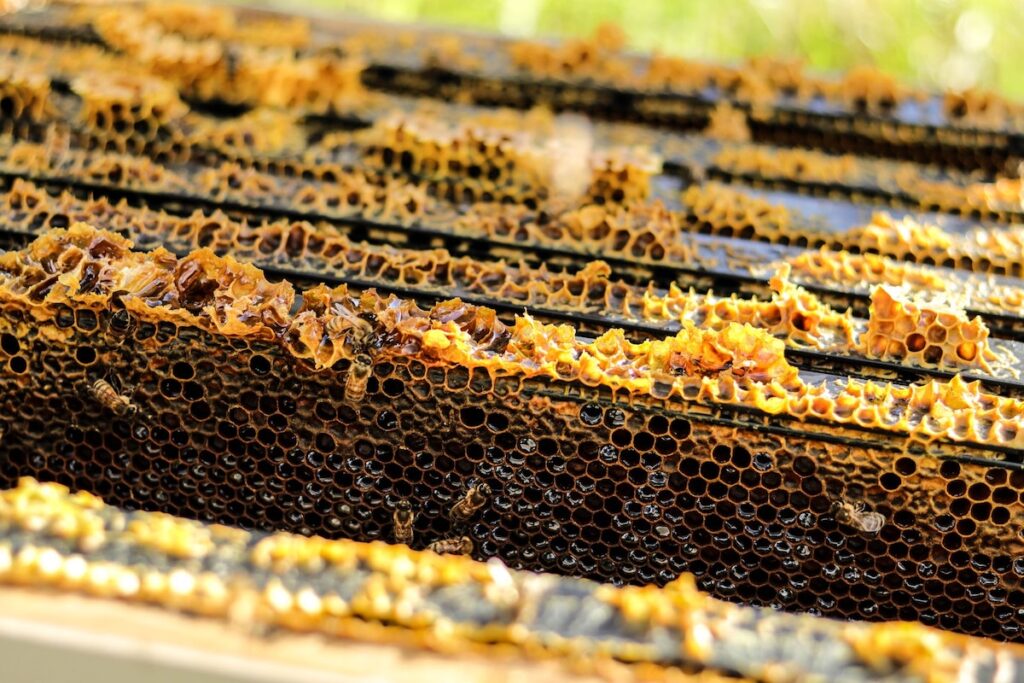The recent death of bees in the northernmost Croatian region of Međimurje provoked numerous media reactions and brought back to the public, at least briefly, questions about the state of beekeeping in our country. This was an incentive to investigate the situation on the island of Hvar, whose honey has been known for more than half a millennium and which had the status as an island brand even before systematic attempts at branding.
Klaudija Bilopavlović – Jurić, who grew up in a family of beekeepers and whose husband is a third generation beekeeper in the village of Velo Grablje, ten kilometers away from the town of Hvar, confirms that the situation is not bright at all. As in Međimurje, several of their hives were devastated by varroasis, which is transmitted by a tiny lice that devours bees. He adds that climate change, along with the uncontrolled use of pesticides and other chemicals in agriculture, is a factor in destroying and preventing the complex natural processes by which bees produce honey. This is especially evident in the lack of necessary humidity that is conducive to bees.
Thousands of years of study of these industrious animals have failed to fully uncover their perfect, astonishingly elaborate system of work and production. Due to this fact, the bee is the only member of the animal and plant world that does not die, but pass away.
Honey, which is a main ingredient in Forski paprenjok, was mentioned in the middle of the 16th century in “Fishing and Fishermen’s Complaints,” a travelogue in verse by the Hvar poet Petar Hektorović. There are no peppercorns in the recipe, in fact it is a type of gingerbread, named after pepper – a common name for all the exotic spices that came to the island of Hvar from distant lands. In the same work, Hektorović mentions that people of his time consumed honey from honeycombs.
Since there is no unifloral honey (from one type of flower) in nature, but it is always a mixture of various plants that diligent bees visit, on the island of Hvar it is possible to find honey with the highest proportion of heather, rosemary, plantain, lavender and sage. The Bilopavlović and Jurić families claim that the best one is heather and rosemary, which is, among other things, a guarantee for excellent gingerbread and paprenjok.
According to the data of senior expert advisor for beekeeping Zlatko Tomljenović, published in 2012, more intensive honey production and beekeeping on Hvar began in the early 20th century with the planting of new lavender plants, and, consequently, the first beekeeping cooperatives were established. The sixties of the last century marked the flourishing of beekeeping on the island of Hvar. There was grazing for local beekeepers who had about 6,000 hives, as well as for beekeepers from the mainland who brought about 15,000 hives during lavender grazing.
In those years, the island produced over 400 tons of high quality honey. This was the case until the 1980s, when fires ravaged the island, so the organized purchase of lavender oil ceased, and lavender plantations were no longer restored. The great fires of 1997 and 2003 further aggravated the situation. Tomljenović states that in 2012, there were about 70 registered beekeepers and 5,000 hives on the island, and the total annual honey production was around 30 tons. The quantities produced are not large, but the honey is of exceptional quality and beekeepers have received numerous awards for lavender and rosemary honey at various competitions in Croatia.
Today, the quantities of honey have been significantly reduced, although the demand remains high. This was especially evident during the coronavirus pandemic, when people were also looking for other bee products – propolis and pollen, due to their known immune-boosting properties. Royal jelly is also in demand, another bee product, but Bilopavlović-Jurić states that there is not much of it because its intensive extraction process destroys bee colonies.
Although the island’s liquid gold seems to be shrouded in a dark sheen, it sees hope in the production and marketing of propolis, especially since awareness and knowledge of its health benefits has increased. Beeswax is also in demand in better and more competitive cosmetics than natural ingredients, which has been flourishing on Hvar in recent years.
Tibor Brindl, a beekeeper who moved to Hvar from Slavonia, the easternmost Croatian region, thinks similarly. Humanity’s adverse effects have significantly weakened the bee’s immune system. There is almost no pasture for bees on the island, so long ago island beekeepers went to the mainland, mostly in Lika. He also emphasizes that the dispersion of hives is needed, meaning, not all hives in the same place, which is impossible on the island. All quality positions are already occupied.
Brindl sees the solution to the unfavorable situation in a product that will preserve the story of honey and everything that Hvar has to offer – in the dessert forski koloc. The story of the Fork cake, a simple dessert in the shape of a circle designed to share and mark all important events in the life of the island inhabitant, and its presentation and offer is a great situation for everyone: Hvar beekeepers can be mobilized, the best honey and other local ingredients included. This can create a foundation for a new quality product and a new authentic experience.
Beekeepers say that despite everything, they are not forgotten and the state recognizes the importance of this branch of animal husbandry not only in economic terms, but because of the disastrous consequences for the entire ecosystem if we allow the death of bees. They agree that the competent institutions should encourage the planting of honey plants, which is why it is necessary to constantly raise awareness of the importance of this craft.
Author: Zorka Bibić

